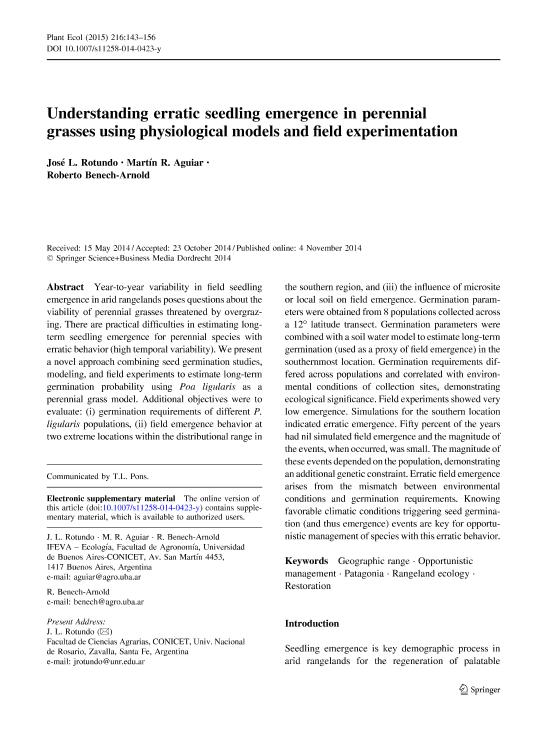Mostrar el registro sencillo del ítem
dc.contributor.author
Rotundo, José Luis

dc.contributor.author
Aguiar, Martin Roberto

dc.contributor.author
Benech-arnold, Roberto Luis

dc.date.available
2016-02-16T20:09:54Z
dc.date.issued
2015-01
dc.identifier.citation
Rotundo, José Luis; Aguiar, Martin Roberto; Benech-arnold, Roberto Luis; Understanding erratic germination in perennial grasses using physiological models and field experimentation.; Springer; Plant Ecology; 216; 1; 1-2015; 143-156
dc.identifier.issn
1385-0237
dc.identifier.uri
http://hdl.handle.net/11336/4224
dc.description.abstract
Year-to-year variability in field seedling emergence in arid rangelands poses questions about the viability of perennial grasses threatened by overgrazing. There are practical difficulties in estimating long-term seedling emergence for perennial species with erratic behavior (high temporal variability). We present a novel approach combining seed germination studies, modeling, and field experiments to estimate long-term germination probability using Poa ligularis as a perennial grass model. Additional objectives were to evaluate: (i) germination requirements of different P. ligularis populations, (ii) field emergence behavior at two extreme locations within the distributional range in the southern region, and (iii) the influence of microsite or local soil on field emergence. Germination parameters were obtained from 8 populations collected across a 12° latitude transect. Germination parameters were combined with a soil water model to estimate long-term germination (used as a proxy of field emergence) in the southernmost location. Germination requirements differed across populations and correlated with environmental conditions of collection sites, demonstrating ecological significance. Field experiments showed very low emergence. Simulations for the southern location indicated erratic emergence. Fifty percent of the years had nil simulated field emergence and the magnitude of the events, when occurred, was small. The magnitude of these events depended on the population, demonstrating an additional genetic constraint. Erratic field emergence arises from the mismatch between environmental conditions and germination requirements. Knowing favorable climatic conditions triggering seed germination (and thus emergence) events are key for opportunistic management of species with this erratic behavior.
dc.format
application/pdf
dc.language.iso
eng
dc.publisher
Springer

dc.rights
info:eu-repo/semantics/openAccess
dc.rights.uri
https://creativecommons.org/licenses/by-nc-sa/2.5/ar/
dc.subject
Biogeografia
dc.subject
Germinación
dc.subject
Limites Climaticos
dc.subject
Control del Suelo
dc.subject.classification
Ecología

dc.subject.classification
Ciencias Biológicas

dc.subject.classification
CIENCIAS NATURALES Y EXACTAS

dc.title
Understanding erratic germination in perennial grasses using physiological models and field experimentation.
dc.type
info:eu-repo/semantics/article
dc.type
info:ar-repo/semantics/artículo
dc.type
info:eu-repo/semantics/publishedVersion
dc.date.updated
2016-03-30 10:35:44.97925-03
dc.journal.volume
216
dc.journal.number
1
dc.journal.pagination
143-156
dc.journal.pais
Alemania

dc.journal.ciudad
Berlin
dc.description.fil
Fil: Rotundo, José Luis. Consejo Nacional de Investigaciones Científicas y Técnicas. Oficina de Coordinación Administrativa Parque Centenario. Instituto de Investigaciones Fisiológicas y Ecológicas Vinculadas a la Agricultura; Argentina
dc.description.fil
Fil: Aguiar, Martin Roberto. Consejo Nacional de Investigaciones Científicas y Técnicas. Oficina de Coordinación Administrativa Parque Centenario. Instituto de Investigaciones Fisiológicas y Ecológicas Vinculadas a la Agricultura; Argentina
dc.description.fil
Fil: Benech-arnold, Roberto Luis. Consejo Nacional de Investigaciones Científicas y Técnicas. Oficina de Coordinación Administrativa Parque Centenario. Instituto de Investigaciones Fisiológicas y Ecológicas Vinculadas a la Agricultura; Argentina
dc.journal.title
Plant Ecology

dc.relation.alternativeid
info:eu-repo/semantics/altIdentifier/url/http://link.springer.com/article/10.1007%2Fs11258-014-0423-y
dc.relation.alternativeid
info:eu-repo/semantics/altIdentifier/issn/1385-0237
dc.relation.alternativeid
info:eu-repo/semantics/altIdentifier/doi/http://dx.doi.org/10.1007/s11258-014-0423-y
Archivos asociados
